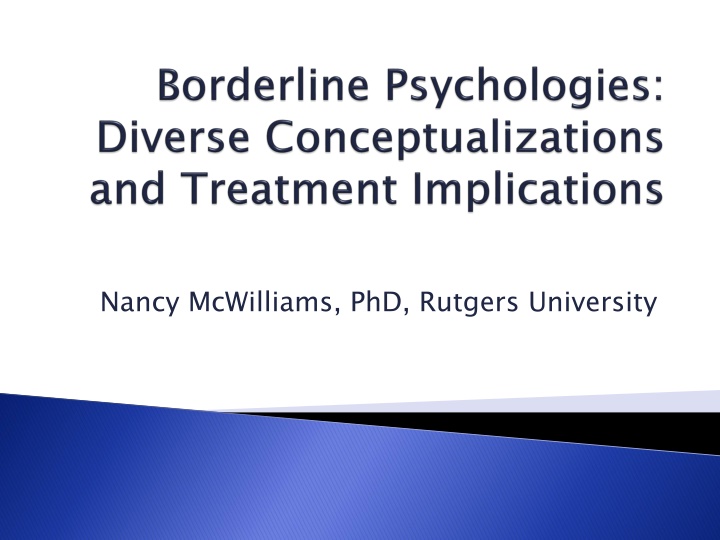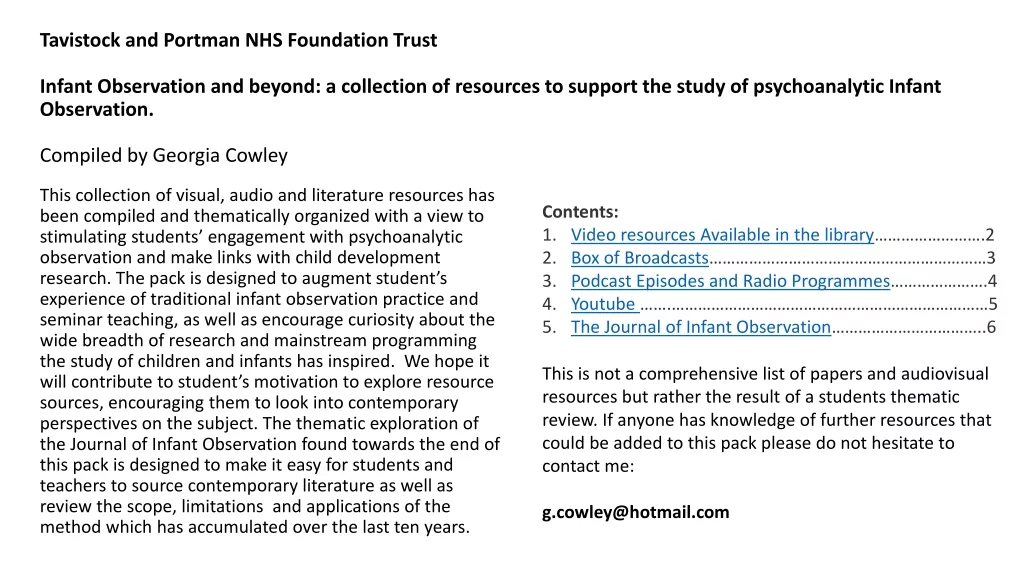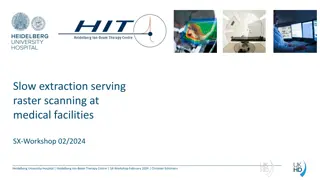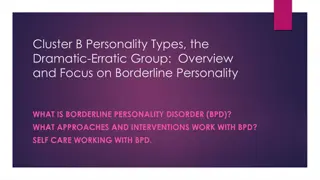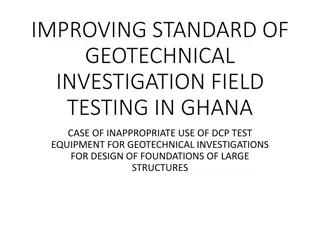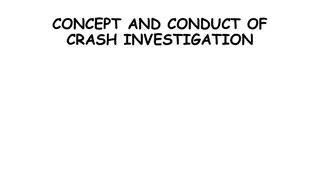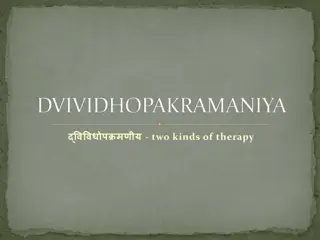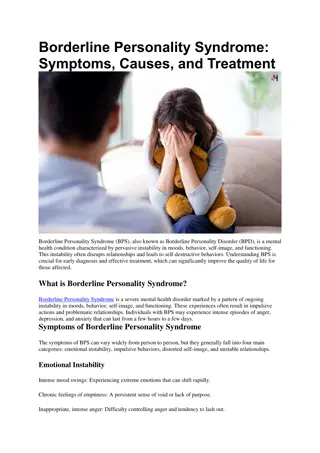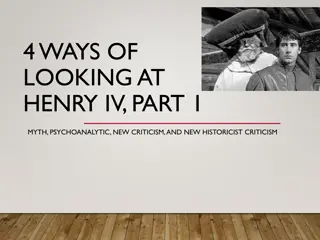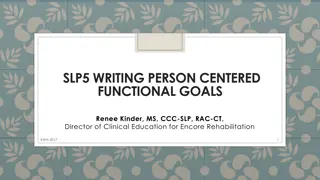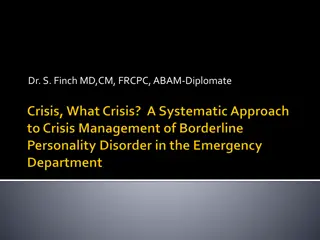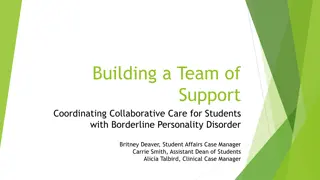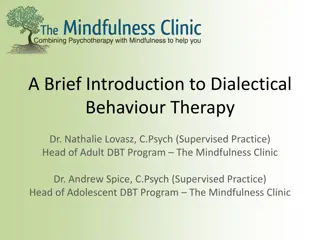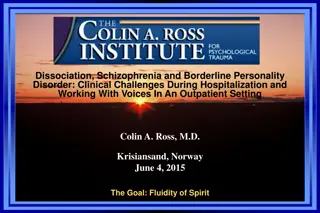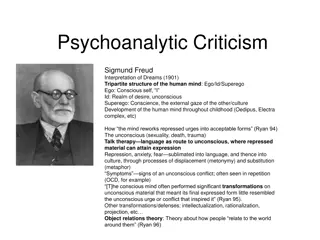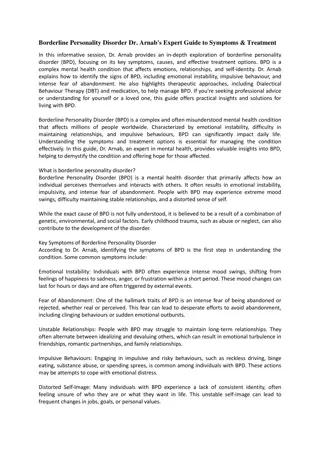Psychoanalytic Investigation and Therapy in Borderline Group of Neuroses
In this compilation, various authors delve into the complexities of borderline personality disorders and pathological narcissism, offering insights into treatment approaches, ego functions, and psychotherapeutic strategies. The exploration of attachment theory, cognitive processes, and emotional disorders provides a comprehensive view of the challenges and potential treatments for individuals with borderline conditions.
Uploaded on Feb 24, 2025 | 0 Views
Download Presentation

Please find below an Image/Link to download the presentation.
The content on the website is provided AS IS for your information and personal use only. It may not be sold, licensed, or shared on other websites without obtaining consent from the author.If you encounter any issues during the download, it is possible that the publisher has removed the file from their server.
You are allowed to download the files provided on this website for personal or commercial use, subject to the condition that they are used lawfully. All files are the property of their respective owners.
The content on the website is provided AS IS for your information and personal use only. It may not be sold, licensed, or shared on other websites without obtaining consent from the author.
E N D
Presentation Transcript
Stern, A. (1938). Psychoanalytic investigation and therapy in the borderline group of neuroses. Psychoanalytic Quarterly, 7, 467-489. Knight, R. (1953). Borderline states. Bulletin of the Menninger Clinic, 17, 1-12. Grinker, R. R., Werble, B., & Drye, R.C. (1968). The borderline syndrome: A behavioral study of ego functions. New York: Basic Books. Hartocollis, P. (Ed.) (1977). Borderline personality disorders: The concept, the syndrome, the patient. New York: International Universities Press. Stone, M. (1980). The borderline syndromes: Constitution, personality, and adaptation. New York: McGraw-Hill.
Kernberg, O. F. (1975). Borderline states and pathological narcissism. New York: Jason Aronson. Kernberg, O. F. (1976). Object relations theory and clinical psychoanalysis. New York: Jason Aronson. Kernberg, O. F. (1984). Severe personality disorders: Psychotherapeutic strategies. New Haven, CT: Yale University Press. Steiner, J. (1993). Psychic retreats: Pathological organizations in psychotic, neurotic and borderline patients. London: Brunner-Routledge.
Masterson, J. F. (1972). Treatment of the borderline adolescent: A developmental approach. New York: Wiley-Interscience. Masterson, J. F. (1976). Psychotherapy of the borderline adult: A developmental approach. New York: Brunner/Mazel. Rinsley, D. B. (1982). Borderline and other self disorders: A developmental and object-relations perspective. New York: Jason Aronson. Adler, G. (1985). Borderline psychopathology and its treatment. New York: Jason Aronson. Cohen, C.P., & Sherwood, V. R. (1996). Becoming a constant object in psychotherapy with a borderline patient. Northvale, NJ: Jason Aronson.
Gunderson, J. G., & Singer, M. T. (1975). Defining borderline patients: An overview. American Journal of Psychiatry, 132, 1-10. Skodol, A. E., Gunderson, J. G, Pfohl, B., et al. (2002). The borderline diagnosis I: Psycho-pathology, comorbidity, and personality structure. Biological Psychiatry, 51: 936-950. Skodol, A. E., Siever, L. J., Livesley, W. J., et al., The borderline diagnosis II: Biology, genetics, and clinical course. Biological Psychiatry, 51: 936-950. Gunderson, J. G., & Hoffman, P. D. (2005). Understanding and treating borderline personality disorder: A guide for professionals and families. Washington, DC: American Psychiatric Association.
Karpman, S. B. (1968). Fairy tales and script drama analysis. Transactional analysis bulletin, 7, 39-43. Guidano, V. F., & Liotti, G. (1983). Cognitive processes and emotional disorders. New York: Guilford Press. Liotti, G., Cortina, M., & Farina, B. (2008). Attachment theory and multiple integrated treatments of borderline patients. Journal of the American Academy of Psychoanalysis and Dynamic Psychiatry, 36, 295-315.
Tomkins, S. S. (1995). Script theory. In E. V. Demos (Ed.), Exploring affect: The selected writings of Silvan Tomkins (pp. 312-388). New York: Cambridge University Press. Panksepp, J. (2004). Affective neuroscience: The foundations of human and animal emotions. New York: Oxford University Press. Panksepp, J., & Biven. L. (2012). The archeology of mind: Neuroevolutionary origins of human emotions. New York: Norton. Anstadt, Th., Merten, J., Ullrich, B., & Krause, R. (1997). Affective dyadic behavior, core conflictual relationship themes and success of treatment. Psychotherapy Research, 7, 397-417.
Fonagy, P., Gergely, G., Jurist, E., & Target, M. (2002). Affect regulation, mentalization, and the development of the self. New York: Other Press. Bateman, A., & Fonagy, P. (2004). Psychotherapy for borderline personality disorder: Mentalization-based treatment. London: Oxford University Press.
Stevenson, J., & Meares, R. (1992). An outcome study of psychotherapy for patients with borderline personality disorder. Amer- ican Journal of Psychiatry, 149, 358-362. Meares, R. (2012). A dissociation model of borderline personality disorder. New York: Norton. Meares, R. (2012). Borderline personality disorder and the conversational model. New York: Norton.
Linehan, M. M. (1993). Cognitive-behavioral treatment of borderline personality disorder. New York: Guilford Press.
Young, J. E. (1999). Cognitive therapy for personality disorders: A schema-focused approach. Sarasota, FL: Professional Resource Press.
Davies, M. G., & Frawley, M. G. (1994). Treating the adult survivor of childhood sexual abuse: A psychoanalytic perspective. New York: Basic Books. Stern, D. B. (1997). Unformulated experience: From dissociation to imagination in psycho- analysis. Hillsdale, NJ: The Analytic Press. Bromberg, P. (1998). Standing in the spaces: Essays on clinical process, trauma, and dissociation. Hillsdale, NJ: The Analytic Press. Maroda, K. J. (2010). Psychodynamic techniques: working with emotion in the therapeutic relationship. New York: Guilford Press.
